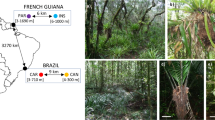Summary
Individual nests of the facultatively polygynous and polydomous ant, Leptothorax curvispinosus, were mapped at two sites, collected, and maintained under uniform laboratory conditions. Tests of worker acceptability between nests were conducted 2–4 weeks and 13–17 weeks after collection. Nests collected near to one another (0.09–1.87 m) were sometimes nonaggressive, and were significantly less aggressive than those from different sites (7 km apart); and there was no significant difference in aggressiveness between tests for these distance categories. However, aggression between nests collected farther away from one another at the same site (1.52–4.65 m) decreased significantly between tests: initially, the level of aggressiveness was equivalent to that between nests from different sites but later it was reduced to that between near nests. These results indicate that polydomous colonies of this species occur within multicolonial populations; and that colony segregation within local populations is largely maintained by transient environmentally-based nestmate recognition cues. More stable cues of genetic or environmental origin (or both) are also present and contribute to discrimination even after extended periods of culture under uniform conditions. These results suggest that the maintenance of colony autonomy within genetically highly interrelated populations may be the prime function of environmentally-based nestmate recognition cues. Colony autonomy under such circumstances may be important to maintain a relatively small but optimal colony size, or because the mechanisms which regulate colony growth, development, etc., require a limited colony size.
Similar content being viewed by others
References
Alloway TM, Buschinger A, Talbot M, Stuart R, Thomas C (1982) Polygyny and polydomy in three North American species of the ant genus Leptothorax Mayr (Hymenoptera: Formicidae). Psyche 89:249–274
Bhatkar A, Whitcomb WH (1970) Artificial diet for rearing various species of ants. Fla Entomol 53:229–232
Breed M (1983) Nestmate recognition in honey bees. Anim Behav 31:86–91
Carlin NF, Hölldobler B (1986) The kin recognition system of carpenter ants (Camponotus spp.). I. Hierarchical cues in small colonies. Behav Ecol Sociobiol 19:123–134
Cherix D (1980) Note preliminaire sur la structure la phenologie et le regime alimentaire d'une super-colonie de Formica lugubris Zett. Ins Soc 27:226–136
Crozier RH, Dix MW (1979) Analysis of two genetic models for the innate components of colony odor in social Hymenoptera. Behav Ecol Sociobiol 4:217–224
Del Rio Pesado MG, Alloway TM (1983) Polydomy in the slave-making ant, Harpagoxenus americanus (Emery) (Hymenoptera: Formicidae). Psyche 90:151–162
Gamboa GJ, Reeve HK, Pfennig DW (1986a) The evolution and ontogeny of nestmate recognition in social wasps. Ann Rev Entomol 31:431–454
Gamboa GJ, Reeve HK, Ferguson D, Wacker TL (1986b) Nestmate recognition in social wasps: The origin and acquisition of recognition odours. Anim Behav 34:685–695
Herbers JM (1986) Nest site limitation and facultative polygyny in the ant Leptothorax longispinosus. Behav Ecol Sociobiol 19:115–122
Herbers JM, Tucker CW (1986) Population fluidity in Leptothorax longispinosus (Hymenoptera: Formicidae). Psyche 93:217–229
Higashi S, Yamauchi K (1979) Influence of a supracolonial ant Formica (Formica) yessensis Forel on the distribution of other ants in Ishikari coast. Jap J Ecol 29:257–264
Hölldobler B, Michener CD (1980) Mechanisms of identification and descrimination in social Hymenoptera. In: Markl H (ed) Evolution of social behavior: Hypotheses and empirical tests. Verlag Chemie, Weinheim, pp 35–58
Hölldobler B, Wilson EO (1977) The number of queens: An important trait in ant evolution. Naturwissenschaften 64:8–15
Jutsum AR, Saunders TS, Cherrett JM (1979) Intraspecific aggression in the leaf-cutting ant Acromyrmex octospinosus. Anim Behav 27:839–844
Mintzer A (1982) Nestmate recognition and incompatibility between colonies of the acacia-ant Pseudomyrmex ferruginea. Behav Ecol Sociobiol 10:165–168
Oster GF, Wilson EO (1978) Caste and ecology in the social insects. Princeton University Press, Princeton, NJ
Parker RE (1979) Introductory statistics for biology. Arnold, London
Provost E (1986) Étude de la femeture de la société chez les fourmis. I. Analyse des interactions entre ouvrières de sociétés differente, lors de recontres expérimentales, chez des fourmis du genre Leptothorax et chez Camponotus lateralis O.L. Insectes Soc 32:445–462
Stuart RJ (1985a) Nestmate recognition in leptothoracine ants: exploring the dynamics of a complex phenomenon. Ph. D thesis, University of Toronto
Stuart RJ (1985b) Spontaneous polydomy in laboratory colonies of the ant Leptothorax curvispinosus Mayr (Hymenoptera; Formicidae). Psyche 92:71–81
Stuart RJ (1986) Use of polyester fibers to mark small leptothoracine ants (Hymenoptera: Formicidae). J Kans Entomol Soc 59:566–568
Stuart RJ (1987a) Individual workers produce colony-specific nestmate recognition cues in the ant, Leptothorax curvispinosus. Anim Behav 35:1062–1069
Stuart RJ (1987b) Nestmate recognition in leptothoracine ants: Testing Fielde's progressive odor hypothesis. Ethology (in press)
Wilson EO (1971) The insect societies. Belknap Press of Harvard University Press, Cambridge, MA
Winer BJ (1971) Statistical principles in experimental design. McGraw-Hill, New York
Author information
Authors and Affiliations
Rights and permissions
About this article
Cite this article
Stuart, R.J. Transient nestmate recognition cues contribute to a multicolonial population structure in the ant, Leptothorax curvispinosus . Behav Ecol Sociobiol 21, 229–235 (1987). https://doi.org/10.1007/BF00292504
Received:
Accepted:
Issue Date:
DOI: https://doi.org/10.1007/BF00292504




